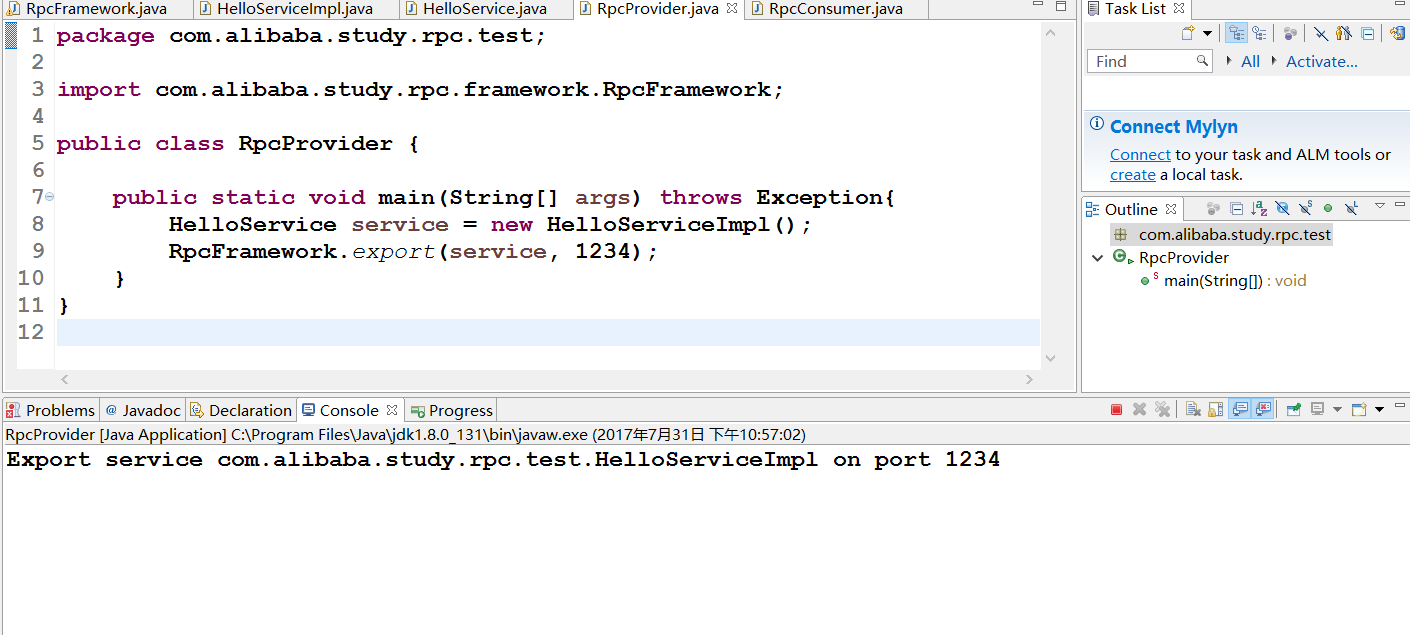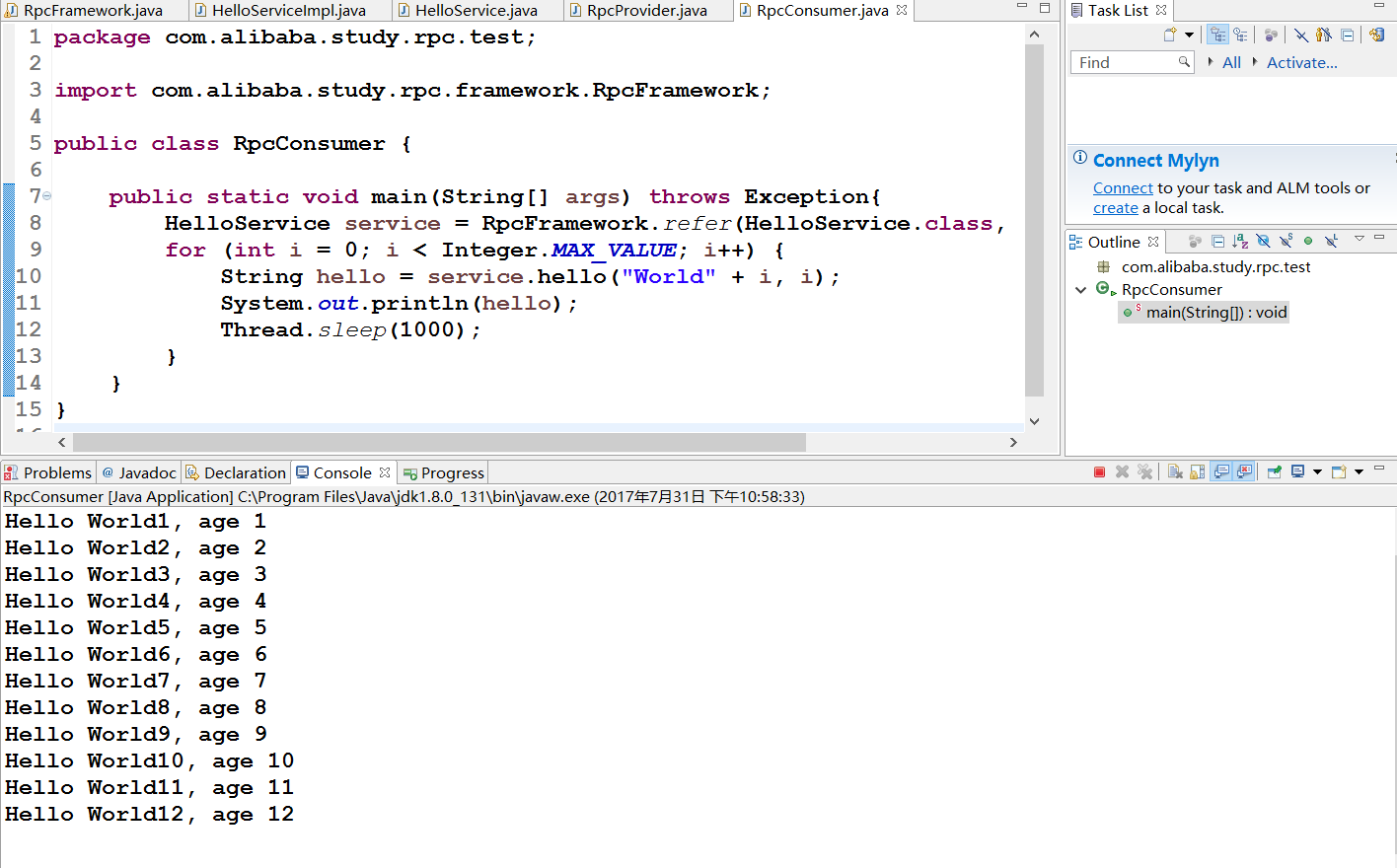本文转载自阿里RPC框架DUBBO的作者粱老师的博客:http://javatar.iteye.com/blog/1123915
通过简单的几行代码就实现了一个RPC框架,对学习其他的RPC框架真的很有帮助。
package com.alibaba.study.rpc.framework;
import java.io.ObjectInputStream;
import java.io.ObjectOutputStream;
import java.lang.reflect.InvocationHandler;
import java.lang.reflect.Method;
import java.lang.reflect.Proxy;
import java.net.ServerSocket;
import java.net.Socket;
public class RpcFramework {
/**
* 暴露服务
* @param service 服务实现
* @param port 服务端口
* @throws Exception
*/
public static void export(final Object service, int port) throws Exception {
if (service == null) {
throw new IllegalAccessException("service install == null");
}
if (port <= 0 || port > 65535) {
throw new IllegalAccessException("Invalid port " + port);
}
System.out.println("Export service " + service.getClass().getName() + " on port " + port);
ServerSocket server = new ServerSocket(port);
for (;;) {
try {
final Socket socket = server.accept();
new Thread(new Runnable() {
@Override
public void run() {
ObjectInputStream input = null;
ObjectOutputStream output = null;
try {
input = new ObjectInputStream(socket.getInputStream());
String methodName = input.readUTF();
Class<?>[] parameterTypes = (Class<?>[])input.readObject();
Object[] arguments = (Object[])input.readObject();
output = new ObjectOutputStream(socket.getOutputStream());
Method method = service.getClass().getMethod(methodName, parameterTypes);
Object result = method.invoke(service, arguments);
output.writeObject(result);
} catch (Exception e) {
e.printStackTrace();
} finally {
try {
if (input != null) {
input.close();
}
if (output != null) {
output.close();
}
} catch (Exception e) {
e.printStackTrace();
}
}
}
}).start();
} catch (Exception e) {
e.printStackTrace();
}
}
}
/**
* 引用服务
*
* @param <T> 接口泛型
* @param interfaceClass 接口类型
* @param host 服务器主机名
* @param port 服务器端口
* @return 远程服务
* @throws Exception
*/
@SuppressWarnings("unchecked")
public static <T> T refer(final Class<T> interfaceClass,
final String host, final int port) throws Exception{
if (interfaceClass == null) {
throw new IllegalAccessException("Interface class == null");
}
if (!interfaceClass.isInterface()) {
throw new IllegalAccessException("The " + interfaceClass.getName() + " must be interface class");
}
if (host == null || host.length() == 0) {
throw new IllegalAccessException("Host == null");
}
if (port <= 0 || port > 65535) {
throw new IllegalAccessException("Invalid port " + port);
}
System.out.println("Get remote service " + interfaceClass.getName() + " from server " + host + ":" + port);
return (T)Proxy.newProxyInstance(interfaceClass.getClassLoader(),
new Class<?>[]{interfaceClass},
new InvocationHandler() {
@Override
public Object invoke(Object proxy, Method method, Object[] args)
throws Throwable {
Object result = null;
ObjectOutputStream output = null;
ObjectInputStream input = null;
try {
Socket socket = new Socket(host, port);
output = new ObjectOutputStream(socket.getOutputStream());
output.writeUTF(method.getName());
output.writeObject(method.getParameterTypes());
output.writeObject(args);
input = new ObjectInputStream(socket.getInputStream());
result = input.readObject();
} catch (Exception e) {
e.printStackTrace();
} finally {
try {
if (input != null) {
input.close();
}
if (output != null) {
output.close();
}
} catch (Exception e) {
e.printStackTrace();
}
}
return result;
}
});
}
}
定义服务接口:
package com.alibaba.study.rpc.test;
public interface HelloService {
String hello(String name, int age);
}实现服务:
package com.alibaba.study.rpc.test;
public class HelloServiceImpl implements HelloService{
@Override
public String hello(String name, int age) {
return "Hello " + name + ", age " + age;
}
}暴露服务:
package com.alibaba.study.rpc.test;
import com.alibaba.study.rpc.framework.RpcFramework;
public class RpcProvider {
public static void main(String[] args) throws Exception{
HelloService service = new HelloServiceImpl();
RpcFramework.export(service, 1234);
}
}引用服务:
package com.alibaba.study.rpc.test;
import com.alibaba.study.rpc.framework.RpcFramework;
public class RpcConsumer {
public static void main(String[] args) throws Exception{
HelloService service = RpcFramework.refer(HelloService.class, "127.0.0.1", 1234);
for (int i = 0; i < Integer.MAX_VALUE; i++) {
String hello = service.hello("World" + i, i);
System.out.println(hello);
Thread.sleep(1000);
}
}
}
运行结果:
总结:
从这个小的Demo我们可以发现,RPC的精髓在于服务端所提供的动态代理,消费者通过接口去调用某个方法,其实最后是通过动态代理来调用到了服务端的真实方法,然而代理中参数,方法,接口的传递是通过TCP作为通讯方式实现而已,如果你有兴趣,还可以用Http进行实现。
2017-11-16补充:
上面的总结总感觉有问题,客户端在调用RPC服务时,客户端有调用服务的接口,而对接口的实现是在服务端进行的,服务端启动,监听某个接口,并将提供的服务(主要是地址+端口+服务)进行注册,你可以注册到内存也可以注册到zookeeper中间件,客户端调用类似于ClientProxy通过动态代理(这段代码是在客户端的),这段代码利用反射将客户端需要调用的服务(接口的字节码、参数、方法)组装成待发送的请求,然后通过网络工具(netty、jetty、mina、selvlet)的客户端经过序列化(Hessian、Jackson、Protostuff)发送到服务端,服务端接收到反序列化然后反射调用,OK























 669
669











 被折叠的 条评论
为什么被折叠?
被折叠的 条评论
为什么被折叠?








